Zhanpeng Zeng
Speculative Decoding Reimagined for Multimodal Large Language Models
May 20, 2025Abstract:This paper introduces Multimodal Speculative Decoding (MSD) to accelerate Multimodal Large Language Models (MLLMs) inference. Speculative decoding has been shown to accelerate Large Language Models (LLMs) without sacrificing accuracy. However, current speculative decoding methods for MLLMs fail to achieve the same speedup as they do for LLMs. To address this, we reimagine speculative decoding specifically for MLLMs. Our analysis of MLLM characteristics reveals two key design principles for MSD: (1) Text and visual tokens have fundamentally different characteristics and need to be processed separately during drafting. (2) Both language modeling ability and visual perception capability are crucial for the draft model. For the first principle, MSD decouples text and visual tokens in the draft model, allowing each to be handled based on its own characteristics. For the second principle, MSD uses a two-stage training strategy: In stage one, the draft model is trained on text-only instruction-tuning datasets to improve its language modeling ability. In stage two, MSD gradually introduces multimodal data to enhance the visual perception capability of the draft model. Experiments show that MSD boosts inference speed by up to $2.29\times$ for LLaVA-1.5-7B and up to $2.46\times$ for LLaVA-1.5-13B on multimodal benchmarks, demonstrating its effectiveness. Our code is available at https://github.com/Lyn-Lucy/MSD.
LightMotion: A Light and Tuning-free Method for Simulating Camera Motion in Video Generation
Mar 11, 2025Abstract:Existing camera motion-controlled video generation methods face computational bottlenecks in fine-tuning and inference. This paper proposes LightMotion, a light and tuning-free method for simulating camera motion in video generation. Operating in the latent space, it eliminates additional fine-tuning, inpainting, and depth estimation, making it more streamlined than existing methods. The endeavors of this paper comprise: (i) The latent space permutation operation effectively simulates various camera motions like panning, zooming, and rotation. (ii) The latent space resampling strategy combines background-aware sampling and cross-frame alignment to accurately fill new perspectives while maintaining coherence across frames. (iii) Our in-depth analysis shows that the permutation and resampling cause an SNR shift in latent space, leading to poor-quality generation. To address this, we propose latent space correction, which reintroduces noise during denoising to mitigate SNR shift and enhance video generation quality. Exhaustive experiments show that our LightMotion outperforms existing methods, both quantitatively and qualitatively.
Semantics Prompting Data-Free Quantization for Low-Bit Vision Transformers
Dec 21, 2024Abstract:Data-free quantization (DFQ), which facilitates model quantization without real data to address increasing concerns about data security, has garnered significant attention within the model compression community. Recently, the unique architecture of vision transformers (ViTs) has driven the development of specialized DFQ techniques. However, we observe that the synthetic images from existing methods suffer from the deficient semantics issue compared to real images, thereby compromising performance. Motivated by this, we propose SPDFQ, a Semantics Prompting Data-Free Quantization method for ViTs. First, SPDFQ incorporates Attention Priors Alignment (APA), which uses randomly generated attention priors to enhance the semantics of synthetic images. Second, SPDFQ introduces Multi-Semantic Reinforcement (MSR), which utilizes localized patch optimization to prompt efficient parameterization and diverse semantics in synthetic images. Finally, SPDFQ employs Softlabel Learning (SL), where soft learning targets are adapted to encourage more complex semantics and accommodate images augmented by MSR. Experimental results demonstrate that SPDFQ significantly outperforms existing methods. For instance, SPDFQ achieves a 15.52% increase in top-1 accuracy on ImageNet for W4A4 ViT-B
Alleviating Distortion in Image Generation via Multi-Resolution Diffusion Models
Jun 13, 2024Abstract:This paper presents innovative enhancements to diffusion models by integrating a novel multi-resolution network and time-dependent layer normalization. Diffusion models have gained prominence for their effectiveness in high-fidelity image generation. While conventional approaches rely on convolutional U-Net architectures, recent Transformer-based designs have demonstrated superior performance and scalability. However, Transformer architectures, which tokenize input data (via "patchification"), face a trade-off between visual fidelity and computational complexity due to the quadratic nature of self-attention operations concerning token length. While larger patch sizes enable attention computation efficiency, they struggle to capture fine-grained visual details, leading to image distortions. To address this challenge, we propose augmenting the Diffusion model with the Multi-Resolution network (DiMR), a framework that refines features across multiple resolutions, progressively enhancing detail from low to high resolution. Additionally, we introduce Time-Dependent Layer Normalization (TD-LN), a parameter-efficient approach that incorporates time-dependent parameters into layer normalization to inject time information and achieve superior performance. Our method's efficacy is demonstrated on the class-conditional ImageNet generation benchmark, where DiMR-XL variants outperform prior diffusion models, setting new state-of-the-art FID scores of 1.70 on ImageNet 256 x 256 and 2.89 on ImageNet 512 x 512. Project page: https://qihao067.github.io/projects/DiMR
LookupFFN: Making Transformers Compute-lite for CPU inference
Mar 12, 2024Abstract:While GPU clusters are the de facto choice for training large deep neural network (DNN) models today, several reasons including ease of workflow, security and cost have led to efforts investigating whether CPUs may be viable for inference in routine use in many sectors of the industry. But the imbalance between the compute capabilities of GPUs and CPUs is huge. Motivated by these considerations, we study a module which is a workhorse within modern DNN architectures, GEMM based Feed Forward Networks (FFNs), and assess the extent to which it can be made compute- (or FLOP-) lite. Specifically, we propose an alternative formulation (we call it LookupFFN) to GEMM based FFNs inspired by the recent studies of using Locality Sensitive Hashing (LSH) to approximate FFNs. Our formulation recasts most essential operations as a memory look-up, leveraging the trade-off between the two resources on any platform: compute and memory (since CPUs offer it in abundance). For RoBERTa language model pretraining, our formulation achieves similar performance compared to GEMM based FFNs, while dramatically reducing the required FLOP. Our development is complemented with a detailed hardware profiling of strategies that will maximize efficiency -- not just on contemporary hardware but on products that will be offered in the near/medium term future. Code is avaiable at \url{https://github.com/mlpen/LookupFFN}.
IM-Unpack: Training and Inference with Arbitrarily Low Precision Integers
Mar 12, 2024Abstract:GEneral Matrix Multiply (GEMM) is a central operation in deep learning and corresponds to the largest chunk of the compute footprint. Therefore, improving its efficiency is an active topic of ongoing research. A popular strategy is the use of low bit-width integers to approximate the original entries in a matrix. This allows efficiency gains, but often requires sophisticated techniques to control the rounding error incurred. In this work, we first verify/check that when the low bit-width restriction is removed, for a variety of Transformer-based models, whether integers are sufficient for all GEMMs need -- for {\em both} training and inference stages, and can achieve parity with floating point counterparts. No sophisticated techniques are needed. We find that while a large majority of entries in matrices (encountered in such models) can be easily represented by {\em low} bit-width integers, the existence of a few heavy hitter entries make it difficult to achieve efficiency gains via the exclusive use of low bit-width GEMMs alone. To address this issue, we develop a simple algorithm, Integer Matrix Unpacking (IM-Unpack), to {\em unpack} a matrix with large integer entries into a larger matrix whose entries all lie within the representable range of arbitrarily low bit-width integers. This allows {\em equivalence} with the original GEMM, i.e., the exact result can be obtained using purely low bit-width integer GEMMs. This comes at the cost of additional operations -- we show that for many popular models, this overhead is quite small.
FrameQuant: Flexible Low-Bit Quantization for Transformers
Mar 10, 2024



Abstract:Transformers are the backbone of powerful foundation models for many Vision and Natural Language Processing tasks. But their compute and memory/storage footprint is large, and so, serving such models is expensive often requiring high-end hardware. To mitigate this difficulty, Post-Training Quantization seeks to modify a pre-trained model and quantize it to eight bits or lower, significantly boosting compute/memory/latency efficiency. Such models have been successfully quantized to four bits with some performance loss. In this work, we outline a simple scheme to quantize Transformer-based models to just two bits (plus some overhead) with only a small drop in accuracy. Key to our formulation is a concept borrowed from Harmonic analysis called Fusion Frames. Our main finding is that the quantization must take place not in the original weight space, but instead in the Fusion Frame representations. If quantization is interpreted as the addition of noise, our casting of the problem allows invoking an extensive body of known consistent recovery and noise robustness guarantees. Further, if desired, de-noising filters are known in closed form. We show empirically, via a variety of experiments, that (almost) two-bit quantization for Transformer models promises sizable efficiency gains.
Vcc: Scaling Transformers to 128K Tokens or More by Prioritizing Important Tokens
May 07, 2023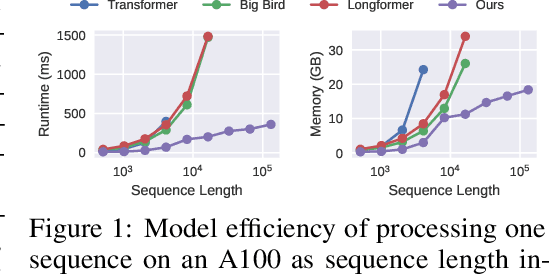
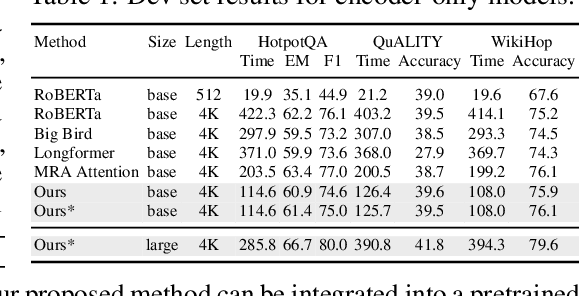
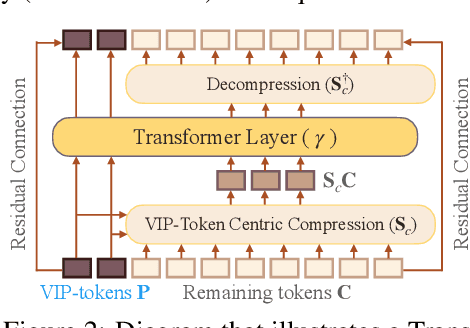
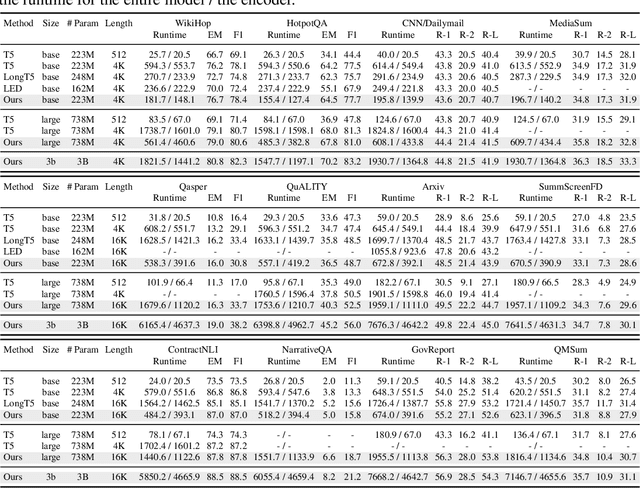
Abstract:Transformer models are foundational to natural language processing (NLP) and computer vision. Despite various recent works devoted to reducing the quadratic cost of such models (as a function of the sequence length $n$), dealing with ultra long sequences efficiently (e.g., with more than 16K tokens) remains challenging. Applications such as answering questions based on an entire book or summarizing a scientific article are inefficient or infeasible. In this paper, we propose to significantly reduce the dependency of a Transformer model's complexity on $n$, by compressing the input into a representation whose size $r$ is independent of $n$ at each layer. Specifically, by exploiting the fact that in many tasks, only a small subset of special tokens (we call VIP-tokens) are most relevant to the final prediction, we propose a VIP-token centric compression (Vcc) scheme which selectively compresses the input sequence based on their impact on approximating the representation of these VIP-tokens. Compared with competitive baselines, the proposed algorithm not only is efficient (achieving more than $3\times$ efficiency improvement compared to baselines on 4K and 16K lengths), but also achieves competitive or better performance on a large number of tasks. Further, we show that our algorithm can be scaled to 128K tokens (or more) while consistently offering accuracy improvement.
Multi Resolution Analysis (MRA) for Approximate Self-Attention
Jul 21, 2022



Abstract:Transformers have emerged as a preferred model for many tasks in natural langugage processing and vision. Recent efforts on training and deploying Transformers more efficiently have identified many strategies to approximate the self-attention matrix, a key module in a Transformer architecture. Effective ideas include various prespecified sparsity patterns, low-rank basis expansions and combinations thereof. In this paper, we revisit classical Multiresolution Analysis (MRA) concepts such as Wavelets, whose potential value in this setting remains underexplored thus far. We show that simple approximations based on empirical feedback and design choices informed by modern hardware and implementation challenges, eventually yield a MRA-based approach for self-attention with an excellent performance profile across most criteria of interest. We undertake an extensive set of experiments and demonstrate that this multi-resolution scheme outperforms most efficient self-attention proposals and is favorable for both short and long sequences. Code is available at \url{https://github.com/mlpen/mra-attention}.
You Only Sample Once: Linear Cost Self-Attention Via Bernoulli Sampling
Nov 18, 2021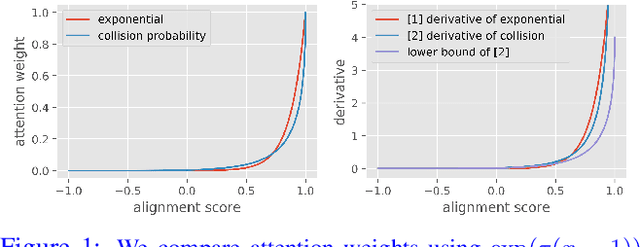


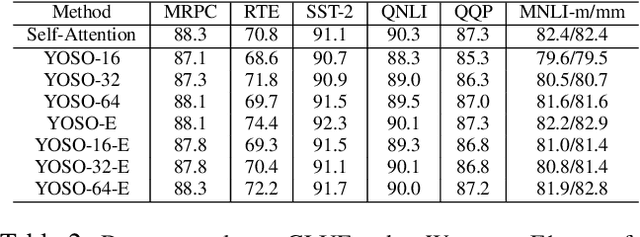
Abstract:Transformer-based models are widely used in natural language processing (NLP). Central to the transformer model is the self-attention mechanism, which captures the interactions of token pairs in the input sequences and depends quadratically on the sequence length. Training such models on longer sequences is expensive. In this paper, we show that a Bernoulli sampling attention mechanism based on Locality Sensitive Hashing (LSH), decreases the quadratic complexity of such models to linear. We bypass the quadratic cost by considering self-attention as a sum of individual tokens associated with Bernoulli random variables that can, in principle, be sampled at once by a single hash (although in practice, this number may be a small constant). This leads to an efficient sampling scheme to estimate self-attention which relies on specific modifications of LSH (to enable deployment on GPU architectures). We evaluate our algorithm on the GLUE benchmark with standard 512 sequence length where we see favorable performance relative to a standard pretrained Transformer. On the Long Range Arena (LRA) benchmark, for evaluating performance on long sequences, our method achieves results consistent with softmax self-attention but with sizable speed-ups and memory savings and often outperforms other efficient self-attention methods. Our code is available at https://github.com/mlpen/YOSO
 Add to Chrome
Add to Chrome Add to Firefox
Add to Firefox Add to Edge
Add to Edge